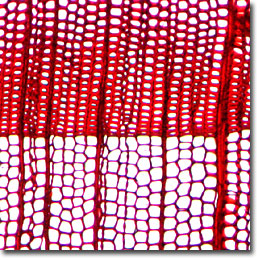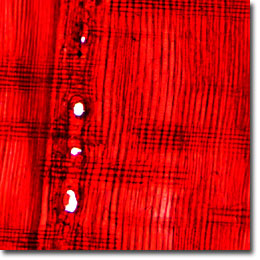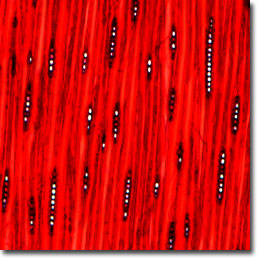The Douglas Fir
The Douglas Fir (Pseudotsuga menziesii) is a softwood tree native to the western United States and British Columbia, and is named for David Douglas, a famous botanist who introduced the seeds into Europe. This tree is among the biggest trees in the world and it is particularly abundant in Oregon and Washington where it forms great forests. The sapwood is whitish to pale yellow (sometimes reddish white), with the heartwood ranging from yellow to pale reddish yellow.

Cross Section

Radial Section

Tangential Section
In Coos Bay, Oregon, there exists a Douglas fir that is 329 feet high (taller than a 16-story building) and 36 feet in circumference. The fir tree in Coos Bay is protected and should (theoretically) never be cut. If it were harvested, the tree would supply more than 60,000 board feet of lumber and plywood, enough to build six complete homes.
The Douglas fir is both valuable for lumber and landscaping, and is quite widely utilized for Christmas trees. The trees often reach a height of 200 feet in the wild, but rarely more than 80 feet when cultivated. The aromatic, flattened needle-like leaves are about an inch long, dark or bluish green in color, and emit an odor similar to camphor.
Fir trees are propagated by seed in the form of cones and are remarkably adaptable, but they prefer cool and deep soil. The Douglas fir is used in building and construction in the form of lumber, timbers, pilings, and large laminated beams and arches for churches, schools, and commercial buildings. Other uses include plan-mill products, railroad car construction, boxes, crates, pallets, containers for corrosive chemicals, silos, tanks, ships and boats, and furniture.
Microscopic examination of iron-alum hematoxylin and safranin stained thin sections (see the digital images presented above) reveals tracheids averaging 35 to 50 micrometers in diameter, and characterized by fine, closely spaced spiral thickening arranged in systems of four to six spirals. Resin canals are present with thick-walled epithelium and lacking tyloses. Bordered pits are occasionally paired on the radial walls.